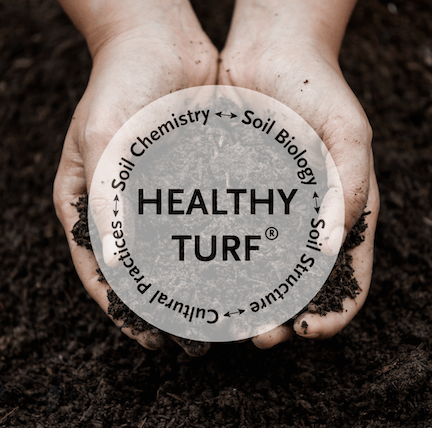Healthy soil for healthy turf means addressing Soil Chemistry, Soil Biology, Soil Structure, and Cultural Practices. As such, we developed our Healthy Turf Circle as the keystone to our practical approach. Each part of this wheel is tantamount to the others in organic turf care. Accordingly, we are influencing the structure of soil solids, the mineral make up and bioavailability of minerals, and organic matter content to provide a continual food source for soil biology.

SOIL TESTING
Soil testing is integral to our program and one of our biggest support services. We do the back-end work for you by interpreting the soil test results. Then, we provide you with an easy to understand deliverable to your customer. We often get asked when to do it and the answer is simple…any time of year! Although, be sure soil testing is not done within a 4-6 window of any granular application. Soil tests give a place to start product and program recommendations for lawns. Importantly, tests are objective and scientific. Therefore, soil test results keep the conversation focused on what’s best to grow the turf grass by influencing soil conditions.

SOIL CHEMISTRY
Soil Chemistry is the first component of the healthy turf circle. Firstly, we are looking primarily to influence the pH of the soil. Then, we can better influence the soil minerals and their bioavailability to the turf plant. In the Northeast, our native soils tend to be acidic. Keep in mind that turf grass wants to grow in soils with a pH of 6.5-6.7. For turf grass, we consider 6.2-6.9 to be an acceptable range, 6.5-6.7 is ideal. This is important because the bioavailability of plant nutrients increases tremendously when soil pH is in range.
SOIL BIOLOGY
The Soil Food Web is a great illustration to represent the life cycles of various ‘consumers’ within the terrestrial biosphere. For turf grass, we are looking to encourage nitrifying (Nitrobacter) or nitrogen fixing bacteria (azotobacter). The symbiotic relationship of soil of microbes and the plants – they are effectively feeding. Predominantly bacterial soils with balanced fungal populations are what we are looking for in turf grass.
SOIL STRUCTURE
Our goal is to influence the nutrient holding capacity of the soil by addressing organic matter and CEC deficiencies. Soils with higher organic matter and CEC can better hold onto water and nutrients and make them available for the turf plant when it needs them. Humic acids are a tremendous option to help influence soil CEC and are found in soil as “HUMUS”. Humic acids can take millennia to develop in a native soil on their own. So, by adding them in a low dose manner, in the form of ‘humates’ we can encourage healthier soil by presenting the critical component to add more binding sites for cations.
CULTURAL PRACTICES
The fourth element of our Healthy Turf Circle is cultural practices. You can sink your program if you don’t pay close attention to your cultural practices. Above all, it’s important to remember that it takes time to make significant changes to soil conditions. Therefore, it’s critical to get the cultural practices right to build year over year success.
- Mowing – Adjust mowing height and frequency according to the season.
- Watering – PJC has adopted the 1-2-3-2-1 watering method.
- Aerating – alleviate compaction and get essential nutrients directly into the rhizosphere. Furthermore, aeration also allows for better air movement and water movement in the soil profile.
- Overseeding – get seed-to-soil contact and establish new turf stands and crowd out weeds.
- Weed management – When you are looking at weeds present in your lawn, ask yourself: “Why is this weed here?” The answer always comes back to the underlying soil conditions.
- Turf Blankets – an amazing tool to cheat winter cold and capture as much sun as you can over the winter months. In addition, turf blankets will help with faster germination in the spring for early season seeding.
Since we need healthy soil for turf to grow well, PJC’s Healthy Turf Circle provides the framework for this to happen. If you’re interested in talking more about how our practical approach and proven products can take your turf to the next level, contact us!








